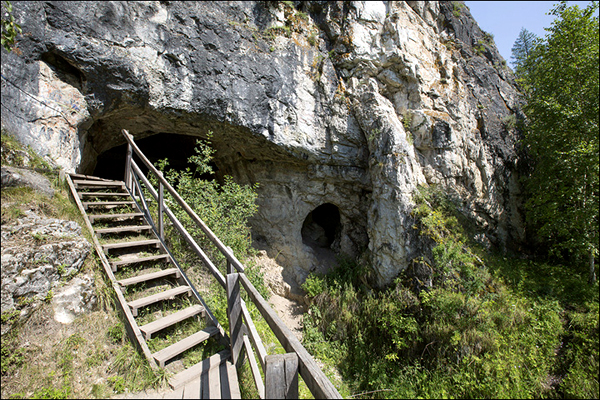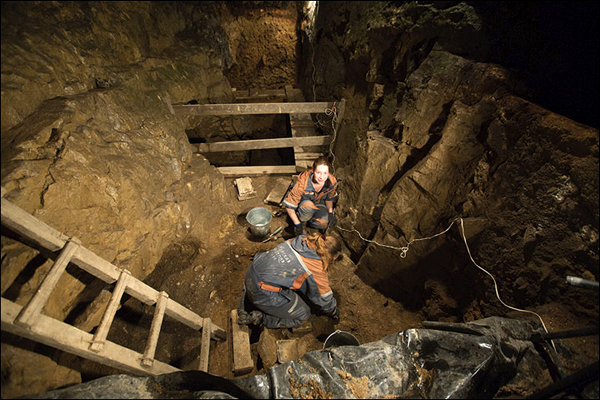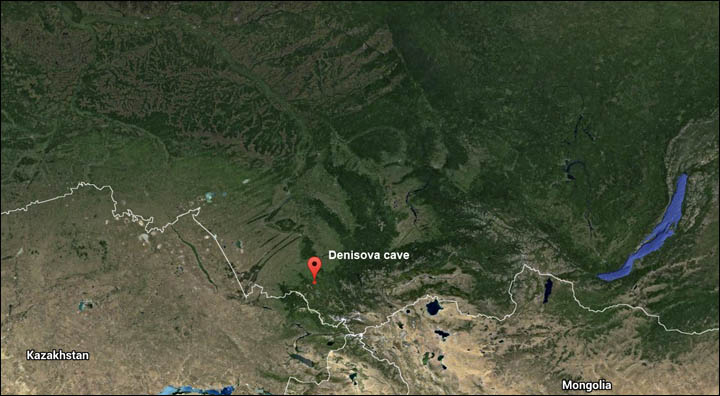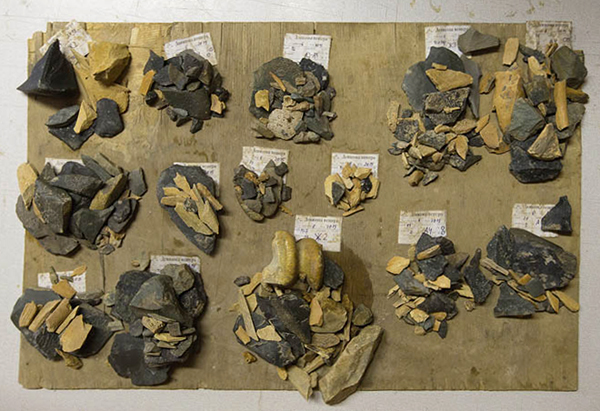


An online article by Anna Liesowska on the siberiantimes website - First glimpse inside the Siberian cave that holds the key to man's origins - reports on new revelations on human origins expected as Novosibirsk State University experts share latest ancient finds with world's leading specialists.

The Denisova Cave in the Altai Mountains has revealed some significant scientific discoveries relating to humankind's origins in recent years. More are expected as a result of the current archeological activity carried out by specialists from Novosibirsk State University and Oxford University.
In 2008 a finger bone fragment of 'X woman' was discovered; a juvenile female who lived around 41,000 years ago, and analysis of which indicated that she was genetically distinct from Neanderthals and modern humans. This previously unknown and long extinct hominin species or subspecies was christened Denisovan after the cave. In 2010 analysis on an upper molar from a young adult, found in the cave ten years previously, was also from a Denisovan.

In 2011, a toe bone contemporary with the finger was found with the mitochondrial DNA suggesting it belonged to a Neanderthal, not a Denisovan. Tools from modern man have also been found in the cave.
Scientist Svante Paabo, from the Max Planck Institute for Evolutionary Anthropology in Leipzig, Germany, has stated that the Denisova Cave is the one place where we are sure all three human forms have lived at one time or another.
Another significant find in 2008 - in the same layer as the Denisovan bone - was a stone bracelet dated 40,000 years old, but it was made using the technologies specific to a much later time.
Scientists now believe that the settlement of this part of Siberia went back longer than the assumed 30,000 to 50,000 years. Traces in the 'cultural layer' of Denisova show the human habitat reaching back 282,000 years. So far it has given up more than 80,000 artefacts including implements, arms, ornaments, and the remains of animals and plants.

The Denisova Cave is located in the Bashelaksky Range of the north-western Altai Mountains, close to the border of today's Altai Region and the Altai Republic. Geographically, it would have been an attractive location, at an altitude of 670 meters above sea level, 28 meters above the present level of the Anui River and with wide valleys to the north and to the south. The cave itself is located - effectively - over a canyon.
In the late Pleistocene era, some 100,000 years ago, an ice sheet covered much of western Siberia, but not Altai valleys such as this. It was a refuge; a good place for hunting and gathering plants. There are several Palaeolithic sites along the Anui River such as Anui-2 and Karakol.

Excavations reveal that the most ancient - 22nd - layer of Denisova Cave is sterile, with no artefacts, as 300,000 years ago the Anui River had another bed, which was located higher, very close to the entrance of the cave. As soon as its course became lower, humans and animals begin to visit the cave. On the upper part of the 22nd layer implements and the remains of animals have been found. This happened around 282,000 years ago, with a mild climate for oak, hornbeam, Manchurian walnut and even the northern species of bamboo. We see here the remains of European ass, bison, woolly rhino, several species of deer, elk, cave lion, cave hyena, bear, and snow leopard.
Work in the well-concealed cave began in 1977 with paleontologist Nikolay Ovodov and later with Alexey Okladnikov. Since 1984, archaeological expeditions have worked here every summer, and a permanent archaeological camp was established in 1990. But even after 30 years of research, the cave is believed to be capable of further revelations. For example, the area known as the central hall adjoining the southern gallery, which is about 20 metres wide, is fully covered with unexplored sediment.
In the eastern gallery, the famous 11th layer revealed the Denisovan's finger bone, bracelet and a necklace of elk teeth. Scientists are now working with the 12th, 13th, and 14th layer - the Middle Paleolithic. The 14th layer is dated about 180,000 years ago. Here there are typical Middle Paleolithic stone implements.
Excavations continue sequentially.
Visit the ORIGINS section:
by Bradshaw Foundation
Monday 04 December 2023
by Bradshaw Foundation
Friday 30 June 2023
by Bradshaw Foundation
Thursday 06 April 2023
by Bradshaw Foundation
Thursday 24 November 2022
by Bradshaw Foundation
Tuesday 27 September 2022
by Bradshaw Foundation
Thursday 08 September 2022
by Bradshaw Foundation
Tuesday 19 July 2022
by Bradshaw Foundation
Monday 06 June 2022
by Bradshaw Foundation
Friday 11 March 2022
by Bradshaw Foundation
Wednesday 02 March 2022
by Bradshaw Foundation
Thursday 26 August 2021
by Bradshaw Foundation
Monday 16 August 2021
by Bradshaw Foundation
Tuesday 06 July 2021
by Bradshaw Foundation
Thursday 06 May 2021
by Bradshaw Foundation
Thursday 06 May 2021
by Bradshaw Foundation
Tuesday 16 March 2021
by Bradshaw Foundation
Monday 04 December 2023
by Bradshaw Foundation
Friday 30 June 2023
by Bradshaw Foundation
Thursday 06 April 2023
by Bradshaw Foundation
Thursday 24 November 2022
by Bradshaw Foundation
Tuesday 27 September 2022
by Bradshaw Foundation
Thursday 08 September 2022
by Bradshaw Foundation
Tuesday 19 July 2022
by Bradshaw Foundation
Monday 06 June 2022
by Bradshaw Foundation
Friday 11 March 2022
by Bradshaw Foundation
Wednesday 02 March 2022
by Bradshaw Foundation
Thursday 26 August 2021
by Bradshaw Foundation
Monday 16 August 2021
by Bradshaw Foundation
Tuesday 06 July 2021
by Bradshaw Foundation
Thursday 06 May 2021
by Bradshaw Foundation
Thursday 06 May 2021
by Bradshaw Foundation
Tuesday 16 March 2021
Friend of the Foundation











